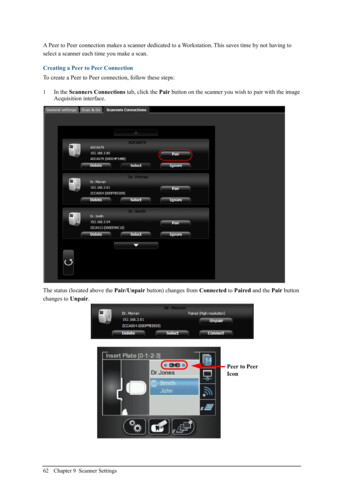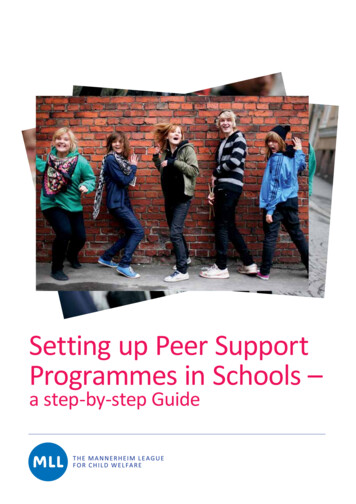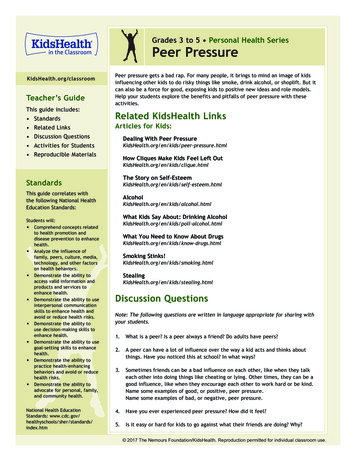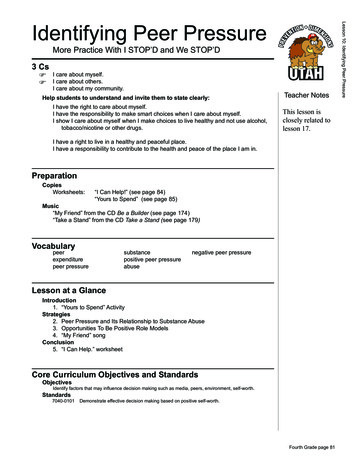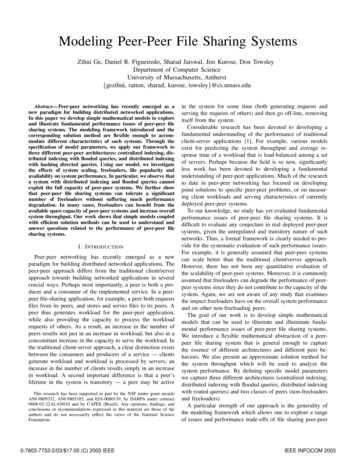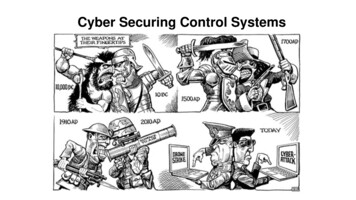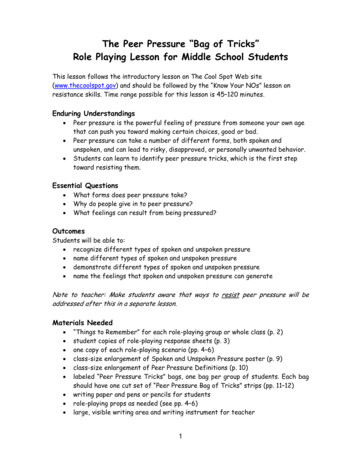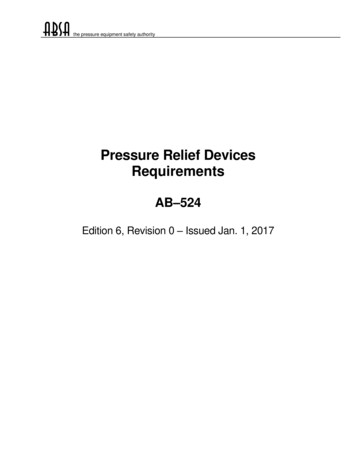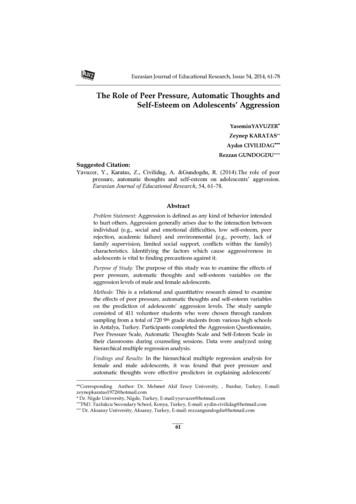
Transcription
Eurasian Journal of Educational Research, Issue 54, 2014, 61-78The Role of Peer Pressure, Automatic Thoughts andSelf-Esteem on Adolescents’ AggressionYaseminYAVUZER Zeynep KARATAS**Aydın CIVILIDAG Rezzan GUNDOGDU****Suggested Citation:Yavuzer, Y., Karatas, Z., Civilidag, A. &Gundogdu, R. (2014).The role of peerpressure, automatic thoughts and self-esteem on adolescents’ aggression.Eurasian Journal of Educational Research, 54, 61-78.AbstractProblem Statement: Aggression is defined as any kind of behavior intendedto hurt others. Aggression generally arises due to the interaction betweenindividual (e.g., social and emotional difficulties, low self-esteem, peerrejection, academic failure) and environmental (e.g., poverty, lack offamily supervision, limited social support, conflicts within the family)characteristics. Identifying the factors which cause aggressiveness inadolescents is vital to finding precautions against it.Purpose of Study: The purpose of this study was to examine the effects ofpeer pressure, automatic thoughts and self-esteem variables on theaggression levels of male and female adolescents.Methods: This is a relational and quantitative research aimed to examinethe effects of peer pressure, automatic thoughts and self-esteem variableson the prediction of adolescents’ aggression levels. The study sampleconsisted of 411 volunteer students who were chosen through randomsampling from a total of 720 9th grade students from various high schoolsin Antalya, Turkey. Participants completed the Aggression Questionnaire,Peer Pressure Scale, Automatic Thoughts Scale and Self-Esteem Scale intheir classrooms during counseling sessions. Data were analyzed usinghierarchical multiple regression analysis.Findings and Results: In the hierarchical multiple regression analysis forfemale and male adolescents, it was found that peer pressure andautomatic thoughts were effective predictors in explaining adolescents’**Corresponding Author: Dr. Mehmet Akif Ersoy University, , Burdur, Turkey, E-mail:zeynepkaratas1972@hotmail.com* Dr. Nigde University, Nigde, Turkey, E-mail:yyavuzer@hotmail.com PhD. Tuzlukcu Secondary School, Konya, Turkey, E-mail: aydin-civilidag@hotmail.com**** Dr. Aksaray University, Aksaray, Turkey, E-mail: rezzangundogdu@hotmail.com61
62Yasemin Yavuzer, Zeynep Karataş, Aydın Civilidağ, & Rezzan Gündoğduaggression levels. Furthermore, it was found that automatic thoughts fullymediated the relationship between self-esteem and aggression for bothmale and the female adolescents.Conclusions and Recommendations: It was found that peer pressure andautomatic thoughts have a significant effect on adolescent aggression. Inworks related to the prevention of aggression, it is vital to teachadolescents how to cope with peer pressure and how to say “no”. On thebasis of these results, we recommend that schools implement workshopsto educate adolescents in aggression and violence prevention. In addition,we recommend using cognitive-behavioral techniques to raise adolescents’awareness of nonfunctioning and aggression-triggering automaticthoughts in order that they may modify these thought patterns.Keywords: Aggression, peer pressure, automatic thoughts, self-esteem,adolescentsAggression is defined as “any kind of behavior intended to hurt others”(Freedman, Sears & Carlsmith, 1989, p. 191). Theories about the causes of aggressionvary according to the subjects they emphasize. Many researchers, such as Freud,McDougall and Lorenz have claimed that people have aggressive urges and instinctsfrom birth (Freedman et al., 1989, p. 194). Bandura (1973) states that children learnaggressive behavior by observing and modeling others. The opposite is also true:children learn not to be aggressive by observing nonaggressive models. Others claimthat aggression occurs from the interaction between individual (e.g., social andemotional difficulties, low self-esteem, peer rejection, academic failure) andenvironmental (e.g., poverty, lack of family supervision, limited social support,conflicts within the family) characteristics (Coie et al., 1993; Miller, 1994). Today, thislatter view is widely accepted.Since adolescence is a transitional phase between childhood and adulthood inwhich physiological, psychological and social changes occur, adolescence is a stormyand stressful period which can causes an imbalance in the adolescent’s thoughts,feelings and behaviors. The fundamental problem in this period is the concept ofindividuation, which refers to consistent self-development. One of the main areas offocus for adolescent behavior is friend and peer relations. Peer groups providesupport, security, membership, autonomy, self-expression and common experiencesto adolescents, and peer pressure is “the influences and pressures adolescents feelfrom their peers” (Adriaansz, 2002). Adolescents inevitably look to their peers forapproval and support.For adolescents who lack positive family relationships, peer pressure plays alarger role in their psychosocial development. Peer pressure can range from positiveeffects to negative effects such as criminal behaviors. Many researchers point out thatadolescents feel an especially strong need to belong to a certain group, which canlead adolescents to engage in risky behaviors (Adriaansz, 2002; Berten, 2008). Austinand Sciarra (2012) express that aggression can be the result of wanting to assert
Eurasian Journal of Educational Research63power, wanting to have an effect over peers or wanting to be a part of this kind ofpower. There are many studies which show the relationship between adolescentaggression and peer pressure (Berten, 2008; Farrell, Kung & White, 2000;Eldeleklioglu, 2007; Gunduz & Celikkaleli, 2009; Hamarus & Kaikkonen, 2008; May,Nichols & Eltzroth, 1999; Sahan, 2007; Yildirim, 2007).Although many studies have examined the relationship between aggression andself-esteem, this relationship still remains controversial. According to one opinion,aggression and anti-social behavior is a sign of low self-esteem (Donnellan,Trzesniewski, Robins, Moffitt, & Caspi, 2005; Duncan, 1999; Sahan, 2007; Yavuz,2007). This view suggests that individuals with low self-esteem behave dominantlyor aggressively mostly in order to increase their own self-esteem. On the other hand,some researchers claim that aggression is due to high (i.e., inflated) self-esteem(Baumeister, Bushman, & Campbell, 2000; Bushman & Baumeister, 1998; Bushman etal., 2009; Perez, Vohs & Joiner, 2005; Schreer, 2002). According to this perspective, ifchildren’s high self-evaluations of behavior and competencies do not correspondwith their peers’ evaluations, children may act aggressively toward those who withdivergent evaluations. In other words, children with high self-esteem may choose toprotect it by acting aggressively towards people who do not agree with theirevaluations. In addition, while the self-esteem of arrogant people increases, theiranger experiences and anger expressions also increases. Furthermore, researchershave found that high self-esteem is sometimes characterized by hostility andaggressiveness, by disregarding others and by, self–centered and egotistic attitudes.Because of this, high self-esteem may be linked to aggression (Perez et al., 2005).According to a third view, there is no link between aggression and self-esteem(Aricak, 1995; Bushman & Baumeister, 2002).According to Beck’s cognitive theory, experiences in childhood cause certainfundamental thoughts and belief systems to be formed through learning, astructural-level development called “schema”. Life events activate the schemas andbring about “negative automatic thoughts”, which lead to unpleasant feelings likeanger, anxiety, guilt and sadness (Demiralp & Oflaz, 2007). Automatic thoughts are“the interpretations that people make related to a situation” (Beck, 2001). They arethe internal dialogues that individuals have about themselves, their world and theirfuture. Generally, being spontaneous, latent and serial, they can appear suddenly inthe human mind. They are combined with certain feelings based on their content andmeaning. Individuals are not generally aware of automatic thoughts, though they areaware of the accompanying feelings. According to Beck (2001), there are fivefundamental cognitive distortions that cause emotional stress. These arepersonalization, polarized thinking (all-or-nothing thinking), selective abstraction,arbitrary inference and overgeneralization. The cognitive structure in Beck’s modelhas been created mostly to explain disorders such as depression and anxiety.Therefore, there is not much research that studies the relationship between thiscognitive structure and externalizing disorders. In their study of the relationshipbetween psychological symptoms and the structure of automatic thoughts, Calveteand Conner-Smith (2005) found that negative automatic thoughts lead to anxiety and
64Yasemin Yavuzer, Zeynep Karataş, Aydın Civilidağ, & Rezzan Gündoğduaggressive behavior. Schniering and Rapee (2004) state that automatic thoughts onhostility or revenge were the strongest predictors of aggression. Beck and Freeman(1990) observed that individuals with passive aggressive behavior disorder haveautomatic thoughts such as “How dare they tell me to do that”, “I will do what Iwant to do”, “People are using me”, “Nothing is going my way” or “People shouldrespect me more”. Furthermore, Calvete, Estevez, Arroyable and Ruiz (2005) found arelationship between cognitive schemas, emotional disorders (depression, anxietyand anger) and automatic thoughts (positive, depressive, anxious and anger-related).In addition, Kurtoglu (2009) found a positive significant relationship betweenadolescents’ levels of aggression and automatic thoughts (negative feelings andthoughts towards themselves, bewilderment, -run-away fantasies, personalincompatibility and a desire to change, loneliness-isolation, and hopelessness).Identifying the factors which cause aggressiveness in adolescents is vital to findingprecautions against it. Accordingly, the purpose of this study was to examine theeffects of peer pressure, automatic thoughts and self-esteem variables on theprediction of male and female adolescents’ aggression levels.The recent rise in aggressive behaviors in adolescents calls for research related tothe causes of this aggression and ways to reduce it. Investigating the variablesrelated to aggression will certainly help identify and prevent the problem. Moreover,the present study is important because there is currently little research like it, and itcan serve as resource for future research in the field.MethodResearch DesignThis is a relational and quantitative study aimed to examine the effects of peerpressure, automatic thoughts and self-esteem variables on male and femaleadolescents’ aggression levels.ParticipantsThe study sample consisted of 411 volunteer students who were chosen throughrandom sampling from a total of 720 9th grade students from various high schools inAntalya, Turkey. Two hundred thirty-eight (57.4%) of these participants were female,and 173 (42.6%) were male.Research InstrumentsAggression Questionnaire (AQ).Developed by Buss and Perry and updated by Bussand Warren (2000), the Turkish version of the Aggression Questionnaire scale wasprepared by Can (2002). The scale consists of five-point Likert responses and 34items. The highest possible score is 170 and the lowest is 34 (Buss & Warren, 2000;Can, 2002). The Aggression Questionnaire is made up of five subscales: physicalaggression, verbal aggression, anger, hostility and indirect aggression. While boththe subscale scores and the total scores can be examined, this study used the totalscores. Can (2002) applied the scale to 300 healthy volunteers who were notdiagnosed according to the Diagnostic and Statistical Manual Disorders IV criteria. In
Eurasian Journal of Educational Research65Can’s test, the Cronbach’s alpha coefficient was r 0.91. For test-retest reliability, thecorrelation coefficient between the two applications in total scores was r 0.85. Forsimilar scale reliability, the Permanent Anger-Anger Expression Scale was used withan Aggression Questionnaire. In the sub-scales, correlation coefficients varied fromr 0.55 to r 0.74 (Can, 2002). Kula (2008), Karatas and Gokcakan (2009), Eroglu (2009),Yavuzer and Ure (2010), Gundogdu (2010) and Donat Baci (2011) used the scale aftertesting its validity and reliability. In this study’s context, the internal consistencycoefficient of the scale was found to be 0.89.Peer Pressure Scale (PPS). Developed by Kiran-Esen (2002), the Peer Pressure Scaleconsists of 34 items. It is a five-point Likert scale and uses the ratings of “never” (1point), “infrequently” (2 points), “sometimes” (3 points), “frequently” (4 points),“always” (5 points). The lowest possible score is 34 and the highest is 170, withhigher scores indicating high levels of peer pressure. Factor analysis was applied forthe scale’s structure validity, and it was found that 19 out of 34 items were combinedin the first factor and 15 items were combined in the second factor (Kiran-Esen, 2002).The total variance that was explained by the two factors was 40.527%. For all of the34 items, the consistency correlation coefficient was 0.90. As a result of the test-retestmethod, the stability coefficient for the whole test was 0.82. In this study, the totalpoints were used and the internal consistency coefficient was found to be 0.93.Rosenberg Self-Esteem Scale (RSES). Developed by Rosenberg (1965) and adaptedinto Turkish by Cuhadaroglu (1986), the Rosenberg Self-Esteem Scale has 12subscales and 63 items. This study used the Self-Esteem subscale, which consists 10items. It is a four-point Likert-type scale including the ratings of “Strongly Disagree”(1 point), “Disagree” (2 points), “Agree” (3 points) and “Strongly Agree” (4 points).The possible scores range from 10 to 40 points, with a higher score indicating highself-esteem for that individual. In the test-retest that was done four weeks after, thecorrelation between the two measurements was found to be r 0.71 (Cuhadaroglu,1986). In this study, the internal consistency coefficient was found to be 0.83.Automatic Thoughts Scale (ATS). Developed by Hollon and Kendall (1980) andadapted into Turkish by Sahin and Sahin (1992), the Automatic Thoughts Scalecontains 30 items. It is a five-point Likert-type scale consisting of the ratings “Nevercrossed my mind” (1 point), “Rarely crossed my mind” (2 points), “Occasionallycrossed my mind” (3 points), “Frequently crossed my mind” (4 points) and “Alwayscrossed my mind” (5 Points). The lowest possible score is 30 and the highest is 150,and a higher score indicates that the individual’s automatic thoughts emergefrequently. According to Sahin and Sahin (1992), item total correlation betweenpoints taken from each item and from the whole scale was 0.30-0.69. In this study, thescale’s internal consistency coefficient was 0.97. The Automatic Thoughts Scale wasdeveloped to identify the automatic thoughts accompanying depression. In theliterature, it has also been used in studies examining the relationship betweenautomatic thoughts and externalizing disorders (Calvete & Connor-Smith, 2005;Calvete et al., 2005; Kurtoglu, 2009).
66Yasemin Yavuzer, Zeynep Karataş, Aydın Civilidağ, & Rezzan GündoğduData AnalysisIn the study, a t test was used to identify the effect of gender on aggression,Pearson’s Product Moment Correlation Analysis was used to identify therelationships between variables, and hierarchical multiple regression analysis wasused to identify the variables that predict aggression. Prior to analysis, thehypothesis of the hierarchical multiple regression analysis was tested. It was foundthat the normality and linearity hypotheses met. In the data analysis, data wereexamined in terms of outlier value. Ten observations from the female participantdata and 10 observations from the male participant data which had outlier value andMahalanobis distance value were taken out of the data set. A moderate level of twopoint correlation between variables indicates that there was no multicollinearitybetween the variables. In addition, the tolerance and VIF values were within theaccepted limits. A Durbin-Watson coefficient was used to test autocorrelation,yielding Durbin-Watson values of 1.694 and 2.142. A 0.05-level of significance wastaken into account in the data analysis. The data from the study were analyzed witha SPSS 13.00 package program.ProcedureThe scales were applied to the participants in their own schools and classroomsduring students’ guidance hour. Basic information about the purpose of the studywas given to the participants and scales were distributed to the adolescents whovolunteered. They were informed that there would be a collective evaluation, andthey were not asked for their credentials personal information. The scales tookapproximately 30-35 minutes to complete.ResultsExamination of the effect of gender on aggressionThe effect of gender on aggression scores were meaningful (t 3.363, p 0.001).According to this finding, male adolescents’ aggression scores (M 89.598, SD 19.633) were higher compared to female adolescents’ aggression scores (M 83.259,SD 18.269).Correlation among the variablesFor aggression, correlation analysis and hierarchical multiple regression analysisbased on preliminary analysis showing the gender differences was done separatelyfor female participants and for male participants. Table 1 shows the correlationsamong the variables.
Eurasian Journal of Educational Research67Table 1Correlation Coefficients between the Variables and Mean and Standard Values Related tothe 173*1.000-0.631**p 0.01Note: AQ Aggression Questionnaire, PPS Peer Pressure Scale, ATS AutomaticThoughts Scale, RSES Rosenberg Self-Esteem Scale.Table 1 demonstrates that there is a moderate level and a positive correlationbetween male adolescents’ aggression scores, peer pressure scale scores (r 0.590;p 0.01) and automatic thoughts scores (r 0.437; p 0.01), as well as a moderate leveland negative correlation between self-esteem scores (r -0.230; p 0.01). The datarelated to female adolescents suggests that while there is a moderate level andpositive correlation between aggression scores peer pressure scale scores (r 0.464;p 0.01) and automatic thoughts scores (r 0.421; p 0.01), there is a moderate level andnegative correlation between self-esteem scores (r -0.293; p 0.01). Predictors ofaggression were examined in three steps using hierarchical multiple regressionanalysis to consider the correlation coefficients between variables. The first stepevaluated peer pressure; the second step, automatic thoughts; and the last step, selfesteem. The analysis results are shown in Table 2.Table 2Hierarchical Multiple Regression Analysis Results Related to Predicting Adolescents’Aggression ScoresMaleFemaleMod.123123Independent VariablesPPSATSRSESPPSATSRSES 6Fch91.483*29.812*0.37864.664*19.841*1.994*p 0.001Note: PPS Peer Pressure Scale, ATS Automatic Thoughts Scale, RSES Rosenberg Self-Esteem Scale.
68Yasemin Yavuzer, Zeynep Karataş, Aydın Civilidağ, & Rezzan GündoğduTable 2 shows that two variables (peer pressure and automatic thoughts) aresignificant predictors in explaining the aggression level of male adolescents. Theresults of the first step of analysis indicate that peer pressure had a significant effect( 0.590, p 0.001). The findings also show that peer pressure scores account for34.9% of the total variance in male adolescents’ aggression levels. Furthermore, itappears that the contribution of the automatic thoughts entered in the second step ofthe model was significant ( 0.320, p 0.001), accounting for9.7% of variance relatedto aggression. Together, these two variables explain 44.6% of the male adolescents’aggression. On the other hand, it appears that self-esteem, entered in the third step,was not a significant predictor ( -0.047, p 0.05).It was found that peer pressure and automatic thoughts are significant predictorsin explaining female adolescents’ aggression levels as well. It appears that thecontribution of peer pressure, which was entered into the model in the first step, wassignificant ( 0.464, p 0.001), accounting for 21.5 % of the total variance in the femaleadolescents’ aggression levels. Immediately following was automatic thoughts, witha 6.1 % contribution to the variance ( 0.273, p 0.001). The two variables togetherexplain 27.6 % of the female adolescents’ aggression. It is found that self-esteem,which was entered in the last step, was not a significant predictor ( -0.102, p 0.05).The findings indicate a moderate level and negative correlation between maleand female adolescents’ aggression scores and self-esteem scores. It was thereforedecided to examine the mediation role of ATS and the relationship between RSESand AQ.A regression analysis of the mediating role of ATS in the relationshipbetween AQ and RSES was conducted in 3 steps, following the model of Baron andKenny (1986).The findings are shown in Table 3.Table 3Regression Analysis of the Mediating Role of ATS in the Relationship between AQ tVariables 60.17820.893**22.108**156.181**25.517***p 0.01, **p 0.001Note: AQ Aggression Questionnaire, ATS Automatic Thoughts Scale, RSES Rosenberg Self-Esteem Scale.
Eurasian Journal of Educational Research69For the male adolescents, in the first step RSES negatively and significantlypredicted AQ ( -0.230, p 0.01), and explained 5.3% of the variation. In the secondstep RSES negatively and significantly predicted ATS ( -0.661, p 0.001), andexplained 43.7% of the variance. In the third step, ATS was identified as a mediatingvariable that positively and significantly predicted AQ ( 0.509, p 0.001). RSES andATS together explained 19.7% of the variance. Furthermore, RSES together with themediating variable (ATS) did not significantly predict AQ ( 0.104, p 0.05). For thefemale adolescents, RSES negatively and significantly predicted AQ ( -0.293,p 0.001), and explained 8.6% of the variation. In the second step RSES negatively andsignificantly predicted ATS ( -0.631, p 0.001), and explained 39.6% of the variance.In the third step, it was observed that taken together with the moderator variable(ATS), there was a reduction in the strength of the correlation between the RSES andthe AQ (see Table 3). These findings indicate that ATS fully mediated therelationship between RSES and AQ for the male adolescents (Sobel z 2.714, p 0.01)and for the female adolescents (Sobel z 2.584, p 0.01).Discussion and ConclusionIn this study of the effects of peer pressure, automatic thoughts and self-esteemon predicting female and male adolescents’ aggression levels, it was found that therewas a moderate level and positive correlation between male and female adolescents’aggression scores, peer pressure and automatic thoughts scores and a moderate leveland negative correlation between self-esteem scores. Furthermore, in the hierarchicalmultiple regression analysis for female and male adolescents, it was found that peerpressure and automatic thoughts were significant predictors in explainingadolescents’ aggression levels. The findings also suggest that the most importantcontribution to the prediction of adolescents’ aggression score levels was peerpressure. This finding is in agreement with previous research findings whichdemonstrate that peer pressure in adolescents is related to aggression (Berten, 2008;Farrell et al., 2000; Eldeleklioglu, 2007; Gunduz & Celikkaleli, 2009; Hamarus &Kaikkonen, 2008; May et al., 1999; Sahan, 2007; Yildirim, 2007). Adolescents’ socialneeds such as belonging to a group, bonding, and finding acceptance may encourageadolescents to submit to the control of a peer group potentially leading them toparticipate in risky behavior. The literature generally agrees that aggression may bethe result of wanting to affect and ascertain power among peers, or of wanting to bea part of such power (Adriaansz, 2002; Austin & Sciarra, 2012; Berten, 2008).In predicting adolescents’ aggression scores, automatic thoughts came in secondplace. A number of research findings which prove that automatic thoughts causeaggressive behavior (Beck & Freeman, 1990; Calvete & Connor-Smith, 2005; Calveteet al., 2005; Kurtoglu, 2009; Schniering & Rapee, 2004) support the findings of thisstudy. Safran and Segal (1990) point out that there are many non-functional thoughts,and that in some cases the individual may exhibit behavior which is consistent withthese thoughts. For example, if the individual perceives other people as aggressive,he/she may act defensively or aggressively.
70Yasemin Yavuzer, Zeynep Karataş, Aydın Civilidağ, & Rezzan GündoğduAnother finding was that self-esteem was not a significant predictor of femaleand male adolescent aggression. This finding is consistent with the findings of Aricak(1995) and Bushman and Baumeister (2002). However, previous studies related to therelationships between self-esteem and aggression has reported conflicting results.There are studies showing that low self-esteem is related to aggression (Donnellan etal., 2005; Duncan, 1999; Sahan, 2007; Yavuz, 2007) and other studies showing thathigh self-esteem is related to aggression (Baumeister et al., 2000; Bushman &Baumeister, 1998; Bushman et al., 2009; Perez et al., 2005; Schreer, 2002). The presentstudy found a moderate level and negative correlation between male and femaleadolescents’ aggression scores and self-esteem scores. After examining the mediationrole of ATS on the relationship between RSES and AQ, it was found that ATS fullymediated the relationship between RSES and AQ for both the male and femaleadolescents. This result shows that, low self-esteem results in automatic thoughtsand that automatic thoughts leads to aggression. As developed by Beck et al., theconcept of the cognitive triad is explained as “a state of having negative thought forone’s self, the world, and the future”. Individuals with this kind of thinking come tohumiliating conclusions about their self-esteem and identity they perceivethemselves as incomplete, worthless, or problematic (Hicdurmaz & Oz, 2011). Therelated literature agrees that once automatic thoughts increases, self-esteemdecreases (Daly & Burton, 1983; Mclennan, 1987; Nielsen et al., 1996; Koydemir &Demir, 2008; Hamarta & Demirbas, 2009; Nasir et al., 2011). According to some,aggression is a sign of low self-esteem (Donnellan et al., 2005), so adolescents may actaggressively in order to increase their own self-esteem.Another finding was that peer pressure and automatic thoughts predictedadolescent aggression in the same prediction order for both sexes but that theprediction values were different between females (27.6%) and males (44.6%). It wasfound that automatic thought provided a 9.7 % contribution in males and 6.1 %contribution in females, which explains the variance (Table 2). The differences amongthe values may be attributed to the peer pressure value. It has been provenpreviously that male adolescents are exposed to more peer pressure than femaleadolescents (Cigdemoglu, 2006; Gunduz & Celikkaleli, 2009; Demir, Baran & Ulusoy,2005; Sari & Kuguoglu, 2009). Moreover, it is more likely for boys to find friends withnegative behavior characteristic (Erdem, Eke, Ogel & Taner, 2006). The reason whypeer pressure is a stronger predictor of male adolescents’ aggression is likely due tothe effect of gender-related perceptions and cultural values. In contemporary culture,male gender roles are more extroverted compared to those of women. In this context,male adolescents who spend more time outside the house with their peers may bemore exposed to greater peer pressure.It was found that peer pressure and automatic thoughts have a significant effecton adolescent aggression. In this study, it was found that ATS fully mediated therelationship between RSES and AQ for male and female adolescents. In worksrelated to the prevention of aggression, it is vital to teach adolescents how to copewith peer pressure and how to say “no”, and for that reason we recommendworkshops in schools to teach students skills in aggression and violence prevention.In addition, we recommend using cognitive-behavioral techniques to raise
Eurasian Journal of Educational Research71adolescents’ awareness of nonfunctioning and aggression-triggering automaticthoughts so that they may change and better control these thoughts.The study group consisted of adolescents at different high schools in the Antalyacity center. Therefore, the results can be generalized to groups with similarcharacteristics. In addition, the data was obtained based on adolescents’ selfevaluations. In future studies, self-evaluations and observers’ (e.g., peers’) ratingswill be used together. Another limitation of the study is that the study groupconsisted only of adolescents in the 9th grade. However, as the grade level (age)increases, adolescent aggression and peer pressure levels may change. Finally, thisstudy only considered adolescents’ total scores from the applied scales. In futurestudies, there can be further investigation using scores obtained from the varioussubscales.ReferencesAdriaanz, G. (2002). Risk behavior in adolescence. Research Report, Retrieved January27, 2012,
fundamental thoughts and belief systems to be formed through learning, a structural-level development called "schema". Life events activate the schemas and bring about "negative automatic thoughts", which lead to unpleasant feelings like anger, anxiety, guilt and sadness (Demiralp & Oflaz, 2007). Automatic thoughts are



